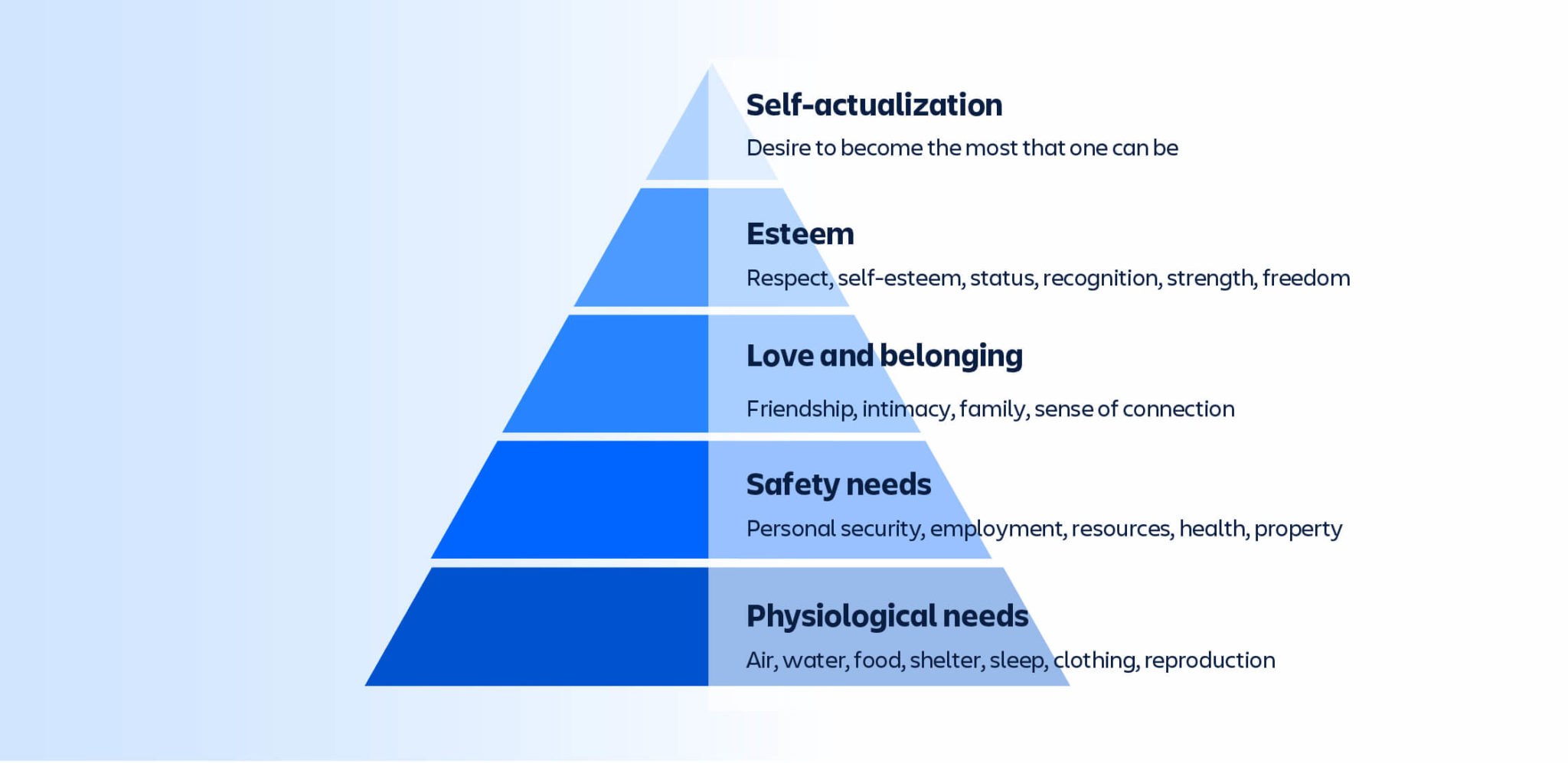Use motivation theory to inspire your team’s best work
5 frameworks for understanding the psychology behind that elusive get-up-and-go.
5-second summary
- Motivation theories explore the forces that drive people to work towards a particular outcome.
- These frameworks can help leaders who want to foster a productive environment understand the psychology behind human motivation.
- Here, we’re outlining five of the most common motivation theories and explaining how to put those theories into practice.
A huge part of a leader’s job is creating an environment where productivity thrives and teams are inspired to do their best work. But that uniquely human brand of motivation can be quite slippery – hard to understand, inspire, and harness.
An academic foundation on motivational theory can help, but opening that door exposes you to enough theoretical concepts and esoteric language to make your eyes glaze over.
This practical guide to motivation theories cuts through the jargon to help you get a solid grasp on the fundamentals that fuel your team’s peak performance – and how you can actually put these theories into action.
What is motivation theory?
Motivation theory explores the forces that drive people to work towards a particular outcome. Rather than accepting motivation as an elusive human idiosyncrasy, motivation theories offer a research-backed framework for understanding what, specifically, pushes people forward.
Motivation theory doesn’t describe one specific approach – rather, it’s an umbrella category that covers a slew of theories, each with a different take on the best “recipe” for motivation in the workplace.
CONTENT THEORIES VS. PROCESS THEORIES
At a high level, motivation theories can be split into two distinct categories: content theories and process theories.
- Content theories focus on the things that people need to feel motivated. They look at the factors that encourage and maintain motivated behaviors, like basic needs, rewards, and recognition.
- Process theories focus on individuals’ thought processes that might impact motivation, such as behavioral patterns and expectations.
5 motivation theories to inspire your team
A quick Google search will reveal dozens of different approaches that promise to unlock relentless ambition on your team.
It’s not likely that a single motivation theory will immediately ignite human-productivity hyperdrive. But the psychology happening behind the scenes gives unique insight into the components that influence human motivation. Leaders can then build on that foundation to create an environment that’s conducive to better focus and enthusiasm.
Let’s get into five of the most common and frequently referenced theories.
1. Maslow’s hierarchy of needs
One of the most well-known motivation theories, the hierarchy of needs was published by psychologist Abraham Maslow in his 1943 paper “A Theory of Human Motivation.”
The gist is that Maslow’s hierarchy outlines five tiers of human needs, commonly represented by a pyramid. These five tiers are:
- Physiological needs: Food, water, shelter, air, sleep, clothing, reproduction
- Safety needs: Personal security, employment, resources, health, property
- Love and belonging: Family, friendship, intimacy, a sense of connection
- Esteem: Status, recognition, self-esteem, respect
- Self-actualization: The ability to reach your full potential

As the term “hierarchy” implies, people tend to seek out their basic needs first (which make up the base of the pyramid). After that, they move to the needs in the next tier until they reach the tip of the pyramid.
In this same paper, however, Maslow clarifies that his hierarchy of needs isn’t quite as sequential as the pyramid framework might lead people to believe. One need doesn’t necessarily have to be fully met before the next one becomes pertinent. These human needs do build on each other, but they’re interdependent and not always consecutive. As Maslow himself said, “No need or drive can be treated as if it were isolated or discrete; every drive is related to the state of satisfaction or dissatisfaction of other drives.”
fun fact
The iconic pyramid associated with Maslow’s theory wasn’t actually created by Maslow — and is even considered somewhat misleading, as you don’t need to “complete” each level before moving forward. The pyramid was popularized decades later by a different psychologist who built upon Maslow’s work along with other management theories.
Maslow’s theory was originally focused on humans’ fundamental needs generally, but in the intervening decades, it’s frequently been adapted and applied to workplaces.
Maslow’s hierarchy of needs in practice
The biggest lesson for leaders here is that you need to have the basics in place before anything else. Because Maslow’s tiers build on each other, a promotion won’t do much to motivate your team members if they’re concerned about the safety of their work environment.
Do your team members feel that they have some level of job security? Are they adequately paid? Do they have safe working conditions? Those are the base requirements you need to meet first.
The hierarchy of needs can support a more holistic approach to management, so you can confirm basic needs and then evolve a more nuanced idea of what people need to thrive. Do they have solid connections with you and their colleagues? Do they receive adequate recognition? Do they have some autonomy in their position?
2. Herzberg’s motivation-hygiene theory (AKA dual-factor or two-factor theory)
Frederick Herzberg, a behavioral scientist, created the motivation-hygiene theory in 1959. The theory is a result of his interviews with a group of employees, in which he asked them two simple questions:
- Think of a time you felt good about your job. What made you feel that way?
- Think of a time you felt bad about your job. What made you feel that way?
Through those interviews, he realized that there are two mutually exclusive factors that influence employee satisfaction or dissatisfaction – hence, this theory is often called the “two-factor” or “dual-factor” theory. He named the factors:
- Hygiene encompasses basic things like working conditions, compensation, supervision, and company policies. When these nuts and bolts are in place, employee satisfaction remains steady – it’s the absence of them that moves the needle. When they’re missing, employee satisfaction decreases.
- Motivators are things like perks, recognition, and opportunity for advancement. These are the factors that, when present, increase employee motivation, productivity, and commitment.
Here’s the easiest way to think of this theory: Hygiene issues will cause dissatisfaction with your employees (and that dissatisfaction will hinder their motivation). Motivators improve satisfaction and motivation – but only when healthy hygiene is in place.
Herzberg’s theory in practice
Herzberg’s two-factor theory is often described as complementary to Maslow’s hierarchy of needs, as both place an emphasis on ensuring an employee’s basic needs – like security, safety, and pay – are being satisfied.
Maslow’s theory is more descriptive, and gives you a comprehensive understanding of the human needs that drive motivation. Herzberg’s theory focuses specifically on prescriptive takeaways for the workplace, giving managers a simple, two-part framework they can use to confirm the presence of hygiene factors before trying to leverage any motivators.
3. Vroom’s expectancy theory
The premise behind Vroom’s expectancy theory, established by psychologist Victor Vroom in 1964, is pretty straightforward: We make conscious choices about our behavior, and those choices are motivated by our expectations about what will happen. In other words, we make decisions to pursue pleasure and avoid pain.
The nuance lies in Vroom’s finding that people value outcomes differently. To unpack that added layer of complexity, Vroom dug a little deeper to explain two psychological processes that influence motivation:
- Instrumentality: People believe that a reward will correlate to their performance.
- Expectancy: People believe that as they increase their effort, the reward increases too.
Vroom’s theory indicates that people need to be able to anticipate the outcome of their actions and behaviors. And, if you want to boost motivation, they need to care about those outcomes.
Vroom’s expectancy theory in practice
Remember that everyone on your team might not be motivated by the same rewards, so your first step is to understand what each of your team members value so you can create opportunities for corresponding outcomes. From there, you can set clear expectations that connect performance to their desired rewards. (This is also what a career development plan does, by the way).
Of course, not every single expectation has a reward directly attached to it. Employees are required to fulfill the responsibilities of their jobs simply because…it’s their job.
Vroom’s theory is all about seeking pleasure and minimizing pain. So, in situations where a reward isn’t relevant, make sure employees are in the loop on what the consequences are if expectations aren’t met.
4. Reinforcement theory
The reinforcement theory is a piece of a broader concept called operant conditioning, which is often credited to psychologist, B.F. Skinner. However, Skinner’s work builds on the law of effect, established by Edward Thorndike in 1898.
Despite its convoluted origins, this is another theory with a simple premise: Consequences shape our behaviors. We’ll repeat behaviors that are reinforced, whether that means they lead to a positive outcome (positive reinforcement) or they end or remove a negative outcome (negative reinforcement).
This theory doesn’t focus on our internal drivers – it’s all about cause and effect. If we do something and like the result, we do it again.
Reinforcement theory in practice
Because this theory is so strongly correlated to human nature (hey, you probably weren’t eager to touch a hot stove again after it burned you once, right?), it’s one of the most intuitive to apply on your team.
When an employee does something desirable, reward that behavior – whether in the form of well-deserved recognition, taking a dreaded task off their plate, or offering a more tangible perk like an extra day off.
5. Self-determination theory
The self-determination theory, introduced by psychologists Richard Ryan and Edward Deci in their 1985 book, focuses on finding motivation within yourself.
Ryan and Deci argue that motivation shouldn’t necessarily be derived from dangling carrots or waving sticks at people. That type is what they refer to as controlled motivation, in which people choose their behaviors based on external results.
Far more powerful than that, the psychologists argued, is autonomous motivation (also known as intrinsic motivation). Under these circumstances, people feel motivated when their choices are aligned with their internal goals and beliefs. Their behaviors aren’t directed by external approval, rewards, and punishments. Instead, their behaviors are self-determined.
Autonomous motivation doesn’t happen on its own. To get there, people need to have three psychological needs met:
- Autonomy: The feeling that they have a choice and some ownership over their behavior
- Competence: The feeling that they are knowledgeable and capable
- Relatedness: The feeling that they are connected to others

When those three boxes are checked, people are better equipped to pull motivation from within, rather than relying on the external factors that are central to so many other motivation theories.
Self-determination theory in practice
You might guess that meeting those three core psychological needs is crucial for this theory – and there’s no need to overcomplicate it.
Here are a few ideas:
- Autonomy: Give employees flexible schedules and the ability to decide for themselves when and where they do their best work.
- Competence: Offer additional trainings and learning opportunities to continue to refine their skills.
- Relatedness: Provide outlets – whether it’s designated Slack channels or team outings – for team members to bond and get to know each other on a more personal level.
That’s not an exhaustive list. You have room to get creative and find other ways to boost your employees’ sense of ownership, proficiency, and connection.
Motivation doesn’t have to be a mystery
Motivation can feel fickle – like a fleeting phenomenon that magically happens when conditions are just right.
But, as your team’s leader, it’s your responsibility to conjure that “just right” environment where people can perform their best work.
You don’t need to be a mind reader to make that happen. Motivation theory can help you identify methods among the madness and create an environment where a high-level motivation is a constant – not a fluke.













































